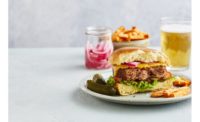Kerry, the Taste & Nutrition company, is pleased to release a research white paper on the exciting emerging topic of protein snack bar development and manufacture. Entitled “Choosing the Right Protein for Your Snack Bar,” the paper examines the rapidly expanding market for snack bars that provide a quality hit of protein and a wide variety of new tastes. In addition, the paper reviews the latest trends in consumer preference in the area of ingredients and bar tastes, important trends and regional regulations in formulation, and the application of plant, dairy and mixed protein in new bar concepts.
“Snackification”—the movement toward snacking versus eating distinct meals—had already been on the rise prior to COVID-19, leading consumers to begin paying much more attention to the nutritional value of snacks. Since the onset of the pandemic, however, consumers have naturally started to feel more vulnerable; this in turn has accelerated a desire to incorporate more healthier foods into their diets as a means to support long-term health goals. Throughout this pandemic, we’ve seen the public rushing to stock up on snacks, whether for a quick and convenient source of nutrition or to provide comfort during these highly challenging times.
Breaking it down further, the appeal of protein specifically—an important nutritional element in health and wellness—has led sales of snack bars with “high” or “added” protein claims to grow exponentially as a category: in 2019 alone, the sector was valued at a remarkable US$6 billion. Globally, snack bar launches featuring high/added protein have moved from 17 percent in 2015 to 33 percent in 2019.
“We believe the upward trend in demand for protein-fortified snacks will continue over the long term, driven by rejuvenated consumer interest in healthy eating and underpinned by dynamic innovation in the category. With new sources of protein being discovered continually and new tastes/delivery formats constantly being innovated, snack bars’ fortunes have taken a noticeable turn upward,” says Mindy Leveille, strategic marketing manager – proteins, Kerry.
“Sales of snack bars with high/added protein claims continue to rise as consumers respond to a ‘feel good’ factor around purchasing snacks that pack an added nutritional punch,” adds Leveille. “Consumers everywhere recognize the value of protein in snack-size portions, and protein-added snack bars are a quick and convenient way for busy people to get a tasty nutrition boost. Our R&D white paper provides a treasure trove of information designed to assist bar manufacturers as they search for just the right protein for their snack bar formulations.”
Key considerations for complex bar challenges
There are a couple of considerations for bar product development to keep top of mind: consumers want alternative plant protein sources; also, there is a growing trend toward “flexitarian” proteins bars — hybrids that incorporate both plant and animal protein. While sustainability in manufacturing is certainly valued, according to Mintel, it is also a fact that as many as 75 percent of consumers believe taste is the most important factor when purchasing a protein product. This is a concern for high-protein content bars, as surveys have revealed that those with health claims are less likely to be perceived as “good tasting” versus comparable products without such assertions.
“There are many emerging ingredients and flavors to apply in protein snack bars, ranging from coffee cold brew to mango to tomato & basil, with the latter being a savory alternative to sweet cereal bars,” said Leveille. “Our white paper presents a number of protein bar concepts to provide inspiration to bar developers for their next new product development.”
Having a clean label is another important concern for consumers, and the advent of new and alternative proteins heralds an opportunity for snack bar manufacturers to innovate and benefit by adopting simpler, clean label formulations. This is especially important for protein bars with high sugar content or those that have been highly processed. Brands are now being pressured to reformulate with simpler ingredients, and to be more transparent about on-pack information. The white paper is available for download here.







